
Prime: Nativity
Hours of Henry VIII
Illuminated by Jean Poyer
Gift of the Heineman Foundation, 1977
Prime: Nativity (fol. 51v)
Of the four evangelists, only Luke (2:7) provides details, though scant, concerning the Nativity: "And she brought forth her firstborn son, and wrapped him in swaddling clothes, and laid him in a manger, because there was no room for them in the inn." Here, however, the child is shown naked, revealing his maleness, and golden rays emanate from his body.
Details about the Nativity derive from the Revelations of St. Bridget of Sweden (c. 1303–73), which influenced depictions of the Birth of Christ in the fifteenth and sixteenth centuries. According to Bridget, an ineffable light and splendor radiated from the child. In her description of the scene, St. Bridget notes that the shepherds—three are peering from the background—uninformed whether the child was male or female, wished to confirm that the child was indeed male; they knew that the Messiah should be a son.
The presence of the ox and ass, not mentioned by the Gospels but included by Bridget, had already been exegetically connected with the Nativity because they were thought to fulfill the prophecy of Isaiah (1:3) that the "ox knoweth his owner, and the ass his master's crib."
Sometimes, as here, the animals are not equal witnesses, but represent the contrast between the Old and New Dispensation, or the Old and New Law. The ox, symbolizing the New Law (of Christ) knowingly looks on, while the view of the other, the Old Law (of Moses), is obscured behind the Virgin, and thus uncomprehending. After the birth, said Bridget, the Virgin immediately worshiped the child, as did Joseph.
The partially obscured object in the lower left corner is the saddle upon which Mary rode during her trip to Bethlehem, where the prophets said that the Messiah would be born.
